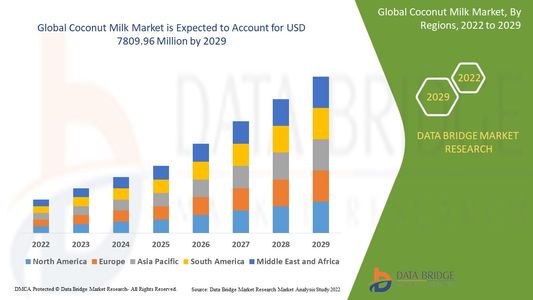Coconut Milk Market Analysis: Trends, Growth, Opportunities & Forecast 2025–2032
 Amol Patil
12 May, 2025
10 mins read
34
Amol Patil
12 May, 2025
10 mins read
34

Introduction to Coconut Milk Market
What is Coconut Milk?
Coconut milk, derived from the grated pulp of mature coconuts, has become a global pantry staple known for its rich, creamy texture and versatility. Unlike coconut water, which is naturally found inside young coconuts, coconut milk is extracted by pressing the coconut meat. It’s widely used in culinary dishes, especially in Southeast Asian, Caribbean, and Indian cuisines, and increasingly in Western diets due to its plant-based appeal. But it’s not just about food anymore — coconut milk has also carved a niche in cosmetics, personal care, and health supplements.
What sets coconut milk apart is its natural fat content, which gives it a lush, dairy-like consistency, making it a favorite among vegans, vegetarians, and the lactose intolerant. Its appeal lies in its functional benefits: it’s free from cholesterol, rich in lauric acid, and offers a decent calorie boost, making it perfect for keto and paleo diets too.
Over the last decade, coconut milk has gone from niche to mainstream, evolving from the shelves of specialty health stores to major supermarket chains. The boom in plant-based diets, rising consumer awareness of food sensitivities, and an increased inclination towards functional foods have all contributed to coconut milk's newfound popularity.
Overview of the Global Market Growth
The global coconut milk market is experiencing unprecedented growth, driven by a perfect storm of health trends, lifestyle changes, and innovation. According to recent market analyses, the coconut milk industry has witnessed a consistent upward trajectory, with a projected compound annual growth rate (CAGR) of 7% to 10% between 2023 and 2030. In monetary terms, the market size is expected to surpass USD 1.5 billion by the end of the forecast period.
A huge part of this expansion is due to changing dietary habits. Consumers are increasingly shifting away from dairy milk, citing ethical, environmental, and health concerns. This has opened the door for alternatives like almond, soy, oat, and coconut milk — with coconut holding a unique position due to its taste, versatility, and traditional value in multiple cultures.
The market is also expanding geographically. While Asia-Pacific remains the dominant player, North America and Europe are catching up fast, fueled by rising vegan populations and health-conscious millennials. Innovations such as flavored coconut milk, barista-grade formulations, and fortified variants are also playing a major role in market proliferation.
Market Dynamics
Key Drivers of Market Growth
Several factors are pushing the coconut milk market into a new era of expansion. First, there's the rising prevalence of lactose intolerance and dairy allergies. An estimated 65% of the global population has some degree of lactose malabsorption, and this number is even higher in Asia, Africa, and South America. Coconut milk presents a natural, digestible alternative without compromising on taste or texture.
Second, the plant-based revolution is real and unstoppable. Consumers are not just looking for substitutes — they’re looking for better options. Coconut milk fits into this narrative perfectly. It’s not only plant-based but also perceived as clean, sustainable, and healthier than many traditional dairy options.
The third big driver is innovation. Brands are no longer offering just plain coconut milk. From low-fat versions to organic, fortified, shelf-stable, and flavored variants (vanilla, chocolate, matcha), the market has diversified significantly. Ready-to-drink coconut milk beverages and coconut milk-based yogurts and ice creams are adding fresh momentum.
Let’s not forget the wellness boom. Coconut milk is rich in antioxidants, medium-chain triglycerides (MCTs), and other compounds that appeal to the health-conscious. Fitness enthusiasts, paleo dieters, and wellness seekers all appreciate its nutritional profile.
Lastly, sustainability concerns are playing a part. Compared to cow’s milk, coconut milk production consumes far fewer natural resources, making it a more eco-friendly choice in the eyes of environmentally aware consumers.
Major Challenges and Restraints
Despite its many advantages, the coconut milk market is not without its hurdles. One of the most significant challenges is the price volatility of raw coconuts. Coconut production is heavily dependent on climate and geography. Droughts, typhoons, and aging coconut trees in key producing countries like the Philippines, Indonesia, and India have led to supply chain instability.
Another restraint is competition. The plant-based milk market is getting crowded, with oat milk, almond milk, and soy milk competing for the same health-conscious audience. Each has its own loyal consumer base, and coconut milk, while versatile, sometimes loses out due to its strong flavor which not everyone prefers.
There’s also the issue of shelf-life and separation. Natural coconut milk, especially organic or preservative-free versions, tends to separate over time. While this is a natural occurrence, it can be off-putting to consumers not familiar with the product.
Additionally, there are concerns around ethical sourcing and fair trade. As demand rises, there is increasing scrutiny over the labor conditions in coconut plantations. Brands will need to adopt transparent sourcing practices to maintain consumer trust.
Opportunities for Market Players
Where there are challenges, there are also opportunities — and the coconut milk market has plenty. First up, there’s significant potential in the functional food and beverage space. Think coconut milk lattes, smoothies, protein shakes, and even fermented coconut milk drinks with probiotics.
Then, there’s the cosmetics and personal care industry. Coconut milk is a sought-after ingredient in shampoos, conditioners, body lotions, and skincare masks due to its moisturizing properties. As the clean beauty trend gains ground, this segment is ripe for expansion.
Geographically, untapped markets in Latin America, Africa, and parts of Eastern Europe offer fertile ground. As awareness grows and distribution networks improve, these regions could significantly boost global consumption.
There’s also an opportunity in B2B. Foodservice providers, cafes, bakeries, and restaurants are incorporating coconut milk into their menus — from vegan curries and soups to dairy-free desserts. Private labeling and foodservice packaging present major B2B growth avenues.
Market Segmentation
By Form (Liquid, Powder)
Coconut milk is primarily available in two forms: liquid and powder. Liquid coconut milk dominates the market and is further divided into canned, tetra pack, and fresh formats. It is commonly used in cooking, baking, and beverages, offering an authentic taste and creamy texture. However, its shorter shelf-life and storage requirements can be a drawback for large-scale operations or remote markets.
Powdered coconut milk, on the other hand, is gaining traction due to its longer shelf life and convenience. It is especially useful in industrial food production, travel kits, and instant food products. The powder form retains most of the nutritional value and can be reconstituted easily by adding water.
While liquid form remains the consumer favorite for its purity and taste, powdered coconut milk is making waves in the B2B segment due to logistical advantages. With improved spray-drying technologies, flavor and texture losses are being minimized, paving the way for broader adoption.
Get More Detail: https://www.databridgemarketresearch.com/reports/global-coconut-milk-market
Written By:
Amol Patil



Hotels at your convenience
Now choose your stay according to your preference. From finding a place for your dream destination or a mere weekend getaway to business accommodations or brief stay, we have got you covered. Explore hotels as per your mood.


